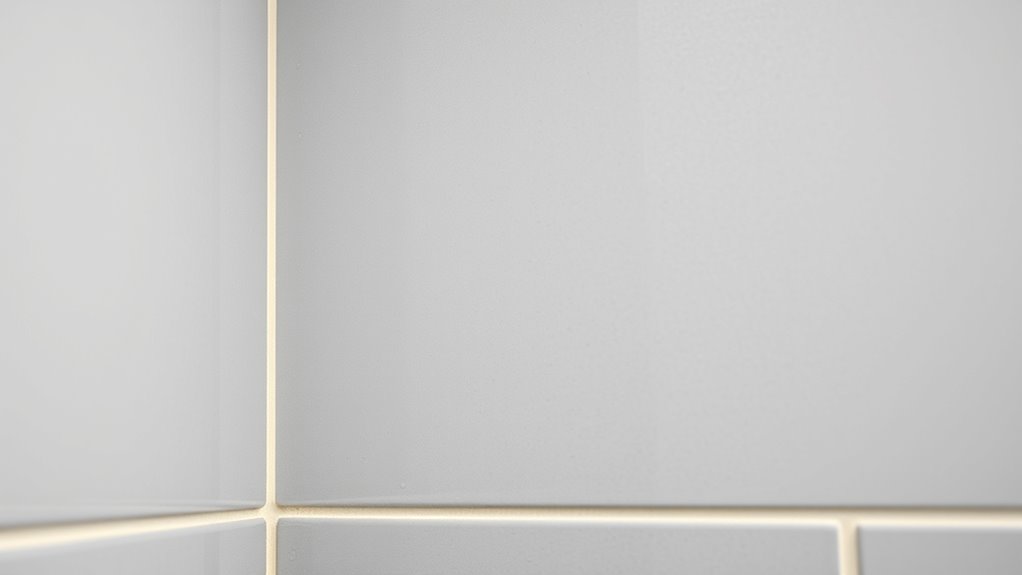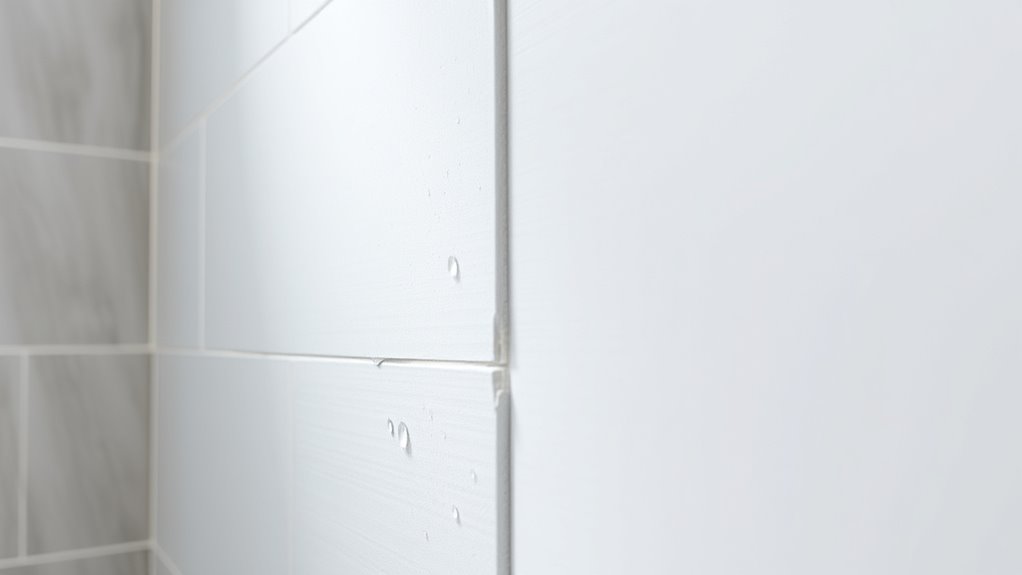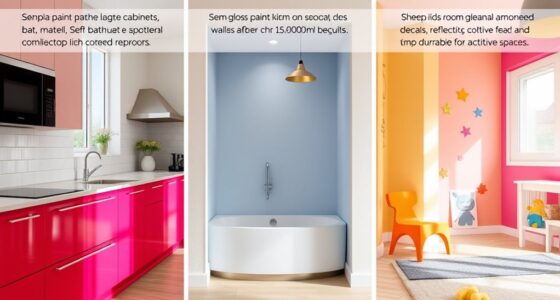Moisture-resistant drywall is essential for wet areas like bathrooms, basements, or laundry rooms, as it helps prevent mold growth and water damage. It contains water-resistant cores and special facing to act as a barrier against moisture infiltration. This drywall not only prolongs the lifespan of your walls but also enhances safety by reducing mold spores and potential health issues. Keep exploring to discover tips on proper installation and maintenance for ideal protection.
Key Takeaways
- Moisture-resistant drywall provides a water barrier, preventing infiltration and reducing mold growth in wet areas.
- It helps maintain healthier indoor environments by limiting mold spores and potential respiratory issues.
- Its fire-resistant properties add safety, especially in utility rooms or areas with electrical components.
- Installation is straightforward, with a slightly higher cost, offering long-term durability and reduced repair needs.
- Acts as a proactive measure to protect walls from water damage, ensuring longevity and safety in damp environments.

Are you tired of dealing with water damage and mold in your walls? If so, moisture-resistant drywall could be your best solution, especially in wet areas like bathrooms, kitchens, or laundry rooms. Traditional drywall absorbs moisture easily, which can lead to warping, deterioration, and, more importantly, mold growth. Moisture-resistant drywall is specifically designed to combat these issues by providing a barrier against water infiltration. It contains water-resistant cores and special faced or unfaced surfaces that help prevent water from penetrating the wall cavity. This makes it an ideal choice for areas prone to humidity and minor leaks, giving you peace of mind that your walls stay dry longer.
One of the main benefits of moisture-resistant drywall is its ability to prevent mold growth. Mold thrives in damp environments, and regular drywall provides an ideal breeding ground. By installing moisture-resistant drywall, you’re reducing the risk of mold spores settling and multiplying inside your walls. This is especially essential for your health, as mold exposure can cause respiratory problems, allergies, and skin irritation. When combined with good ventilation practices and proper sealing, moisture-resistant drywall becomes a powerful tool in mold prevention strategies. It acts as a first line of defense, keeping moisture out and helping to maintain a healthier indoor environment. Additionally, some moisture-resistant drywall options are designed to offer enhanced fire resistance****, which can provide extra safety in wet areas.
Furthermore, moisture-resistant drywall enhances fire resistance, which is imperative in areas where electrical wiring or appliances are present. While it’s not entirely fireproof, it offers increased fire resistance compared to standard drywall. This added safety feature can slow the spread of fire, giving you extra time to evacuate and reducing potential damage. Using moisture-resistant drywall in combination with fire-resistant materials provides a dual layer of protection, making your wet areas safer and more resilient. It’s especially valuable in areas like laundry rooms or utility closets, where both moisture and fire hazards are common.
Installing moisture-resistant drywall isn’t complicated, and it often costs only slightly more than traditional drywall. The investment pays off by prolonging the lifespan of your walls and reducing costly repairs caused by water damage or mold remediation. Its durability means you won’t need to replace it as often, saving you money and effort over time. To guarantee its benefits, ensure proper sealing around edges and fixtures, and maintain good ventilation. This way, you can enjoy a dry, mold-free, and safer environment for years to come. In wet areas, moisture-resistant drywall isn’t just an upgrade; it’s a smart, proactive measure to protect your home.
Frequently Asked Questions
How Long Does Moisture-Resistant Drywall Last in Wet Environments?
Moisture-resistant drywall typically lasts around 15 to 20 years in wet environments if properly installed and maintained. Its drywall durability depends on factors like humidity levels, water exposure, and maintenance. You should regularly check for signs of damage or mold, and ensure proper ventilation to maximize moisture resistance longevity. With good care, it can provide reliable protection in wet areas for many years, but eventual deterioration may occur over time.
Can Moisture-Resistant Drywall Be Painted or Tiled Directly?
You can paint or tile directly on moisture-resistant drywall, but proper preparation is key. About 80% of waterproofing issues come from poor surface prep, so make sure you clean, prime, and sand the drywall first. For painting, use a moisture-resistant primer; for tiling, apply a suitable adhesive. This ensures your finish bonds well and lasts, making your wet area both functional and attractive.
Is Moisture-Resistant Drywall Suitable for Outdoor Use?
Moisture-resistant drywall isn’t ideal for outdoor use because it’s designed mainly for interior moisture protection. For exterior applications, you need drywall with better weather durability, like exterior-grade or cement board. These materials withstand exposure to rain, sun, and temperature changes better. Using moisture-resistant drywall outdoors can lead to damage over time, so always select products specifically made for exterior environments to guarantee longevity and performance.
What Are the Cost Differences Between Regular and Moisture-Resistant Drywall?
Imagine you’re renovating a bathroom, and you find moisture-resistant drywall costs about 20% more than regular drywall. You’ll notice higher material pricing upfront, but installation costs might be similar since both materials are easy to work with. While moisture-resistant drywall is pricier—around $0.50 to $0.75 per square foot compared to $0.30 to $0.50—you save long-term by reducing mold and water damage repairs.
How Does Moisture-Resistant Drywall Handle Mold and Mildew Growth?
Moisture-resistant drywall helps inhibit mold and mildew growth by resisting water absorption. To maximize its effectiveness, you should implement proper ventilation strategies that reduce humidity and promote airflow. Regular cleaning routines also prevent mold spores from settling on surfaces. While the drywall itself offers some protection, combining it with good ventilation and cleaning practices guarantees a healthier, mold-free environment in wet areas.
Conclusion
When you choose moisture-resistant drywall for wet areas, you’re protecting your space like a shield against water damage. It’s a smart choice, especially in bathrooms, kitchens, or basements, where moisture lurks. Think of it as your home’s armor, preventing mold and deterioration. So, don’t overlook this essential step—your walls will thank you for the added durability and peace of mind, just like a sturdy ship braving rough seas.









